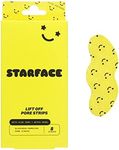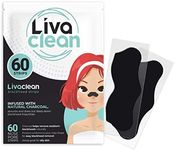Buying Guide for the Best Pore Strips
Choosing the right pore strips can make a big difference in your skincare routine. Pore strips are designed to remove blackheads and impurities from your nose or other areas of your face. To find the best fit for you, it's important to understand what makes each product different and how those differences can affect your skin. By paying attention to a few key features, you can select a pore strip that works well for your skin type and gives you the results you want.MaterialThe material of a pore strip refers to what the strip is made from, such as non-woven fabric, hydrocolloid, or other synthetic materials. This is important because the material affects how well the strip adheres to your skin and how gentle or harsh it feels when removed. Non-woven fabric strips are common and stick firmly, which can be effective but sometimes harsh for sensitive skin. Hydrocolloid strips are gentler and can help with healing, making them a good choice for sensitive or acne-prone skin. If you have sensitive skin, look for softer materials, while those with more resilient skin can use firmer strips for stronger results.
Adhesive StrengthAdhesive strength is how strongly the strip sticks to your skin. This matters because a stronger adhesive can pull out more blackheads and debris, but it can also be more uncomfortable to remove and may irritate sensitive skin. Strips with mild adhesive are better for delicate or easily irritated skin, while those with strong adhesive are suitable for people who want a deeper clean and don't mind a bit of discomfort. Consider your skin's sensitivity and your tolerance for the removal process when choosing the adhesive strength.
Active IngredientsActive ingredients are substances added to the strip to enhance its effectiveness, such as charcoal, tea tree oil, witch hazel, or salicylic acid. These ingredients can help with oil control, soothing the skin, or providing antibacterial benefits. Charcoal is popular for deep cleansing, while tea tree oil and witch hazel are good for calming and reducing redness. If you have oily or acne-prone skin, look for strips with ingredients that target oil and bacteria. For sensitive skin, choose strips with soothing or minimal ingredients.
Size and ShapeThe size and shape of a pore strip determine how well it fits the area you want to treat, such as the nose, chin, or forehead. Some strips are designed specifically for the nose, while others are shaped for broader or smaller areas. A good fit ensures better contact with the skin and more effective removal of impurities. If you want to target specific areas, choose strips designed for those spots. For general use, look for multi-shape packs or strips that can be trimmed to fit.
Ease of UseEase of use refers to how simple the strip is to apply and remove, as well as how long it needs to stay on your skin. Some strips require wetting the skin first, while others can be applied dry. The time needed for the strip to work can range from a few minutes to longer. If you prefer a quick and easy routine, look for strips that are straightforward to use and have a short application time. If you don't mind spending more time, you can choose strips that require a longer process for potentially better results.













